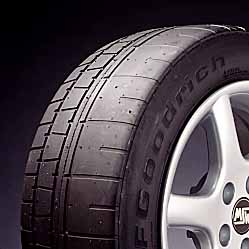Tires - Thoughts on the BFG’s and More |
We ran the BFG Comp T/A
Spec Tire in 5 Pro Races in 1998 (before we stopped running SRF to
concentrate on the Cougar T2 project). We were very happy with the tire and the
tremendous support we got from BFG. While there is no doubt the tire is not quite as
fast as the Yokohama tire it replaces, it has other characteristics which make it a great
tire for SRF. Discussed below are my thoughts and observations on running the tire along
with some general wheel and tire info I’ve collected through the years. in 5 Pro Races in 1998 (before we stopped running SRF to
concentrate on the Cougar T2 project). We were very happy with the tire and the
tremendous support we got from BFG. While there is no doubt the tire is not quite as
fast as the Yokohama tire it replaces, it has other characteristics which make it a great
tire for SRF. Discussed below are my thoughts and observations on running the tire along
with some general wheel and tire info I’ve collected through the years. |
| BFG Comp T/A -- Spec Racer “Special” Stuff |
| First...contrary to what is published and known about the other Comp T/A tires, the Spec Racer version DOES NOT have an asymmetrical sidewall. Many an hour was spent in the early parts of the 1998 Pro Season fooling around with the assumption that the tire had asymmetrical sidewalls. |
| Second...read the information BFG provides on the “Care and Feeding” of this tire. This information was written by Jim Fogarty, the designer of the tire. Believe what he says (ignoring the asymmetrical information) ...especially about the “scrubbing” of the tire. The tires have dramatically different behavior between scrubbed and un-scrubbed. Bluntly, there is no point in trying to race on new, unscrubbed tires. You’ll be slow and the tires will be greasy. |
| Third...setup. Check out our setup info on this site. As you will see, the setup we
ran is very similar to the Yokohama setup. As an aside, in talking to Jim Fogarty,
he told me that one of the design objectives on the tire was to make it as similar to the
Yokohama as possible. In general, this is what we found: - Run the car softer than with the “Yok’s”. We strongly preferred the Koni’s with the BFG tires. Robert always really liked the Penske shocks with the Yokohama tires. He said the car felt way more precise with the Penske’s. And, truthfully, we wanted to keep running the Penske’s for that very reason. Unfortunately, the car simply handled better with the Koni’s. Our supposition is that the softer bump valving of the Koni’s is a better match with the BFG tires. I’m sure that Penske could offer a softer valving on their shock...and I think that ultimately that would be the hot setup...but for now, we recommend Koni’s. And since we won’t be running SRF anymore, you’ll have to decide if the Penske has been “fixed” at the time you read this. - The tires get better as you get into the “under-tread”. At some point, the tires start looking like slicks...i.e. no tread...and, unfortunately, no wear bars. At this point you’re into the under-tread. I can’t tell you how deep the undertread is. After 5 races, we were still running the first set of tires we bought at the beginning of the season...and they were working great. Now, there’s a flip side to this. If your rear tires are slicks and the front tires have tread, you’re going to push. If the front tires are in the under-tread and the rears are brand new (scrubbed of course), you’re going to be loose. You want to keep the front and rear tread depth approximately matched. - Wheels: The BFG’s work well with either the Weld’s or the Alloys. We liked running alloys in front and Weld’s in the rear. The idea here was to get the lower rotational inertia of the Weld’s...and the wider rim width of the rear Weld’s. In the front, we liked the better brake cooling of the alloys combined with the slightly more advantageous offset. That being said, one successful Pro competitor ran the exact opposite wheel configuration...for the same reasons. You decide. |
| Other Tire and Wheel Stuff |
Tire Softeners |
Titanium Wheel Bolts |
Other Weld
Wheel Tips |
| Rev. 11/20/98 |
| Feedback |
| I welcome your comments or ideas on this information. Feel free to drop me
a line via “Comments for the Bro’s”. Barry |
